The word “rodent” comes from Latin and means “to gnaw” — which is exactly what these critters do, with incisors (front teeth) that never stop growing! When you hear the word “rodent”, you probably picture a rat or a mouse. But did you know that squirrels, beavers, chinchillas, and capybaras are rodents too? And some of them can grow really big. Let’s take a look at the largest rodents in the world!
12. Nutria (Myocastor coypus) – 22 Pounds
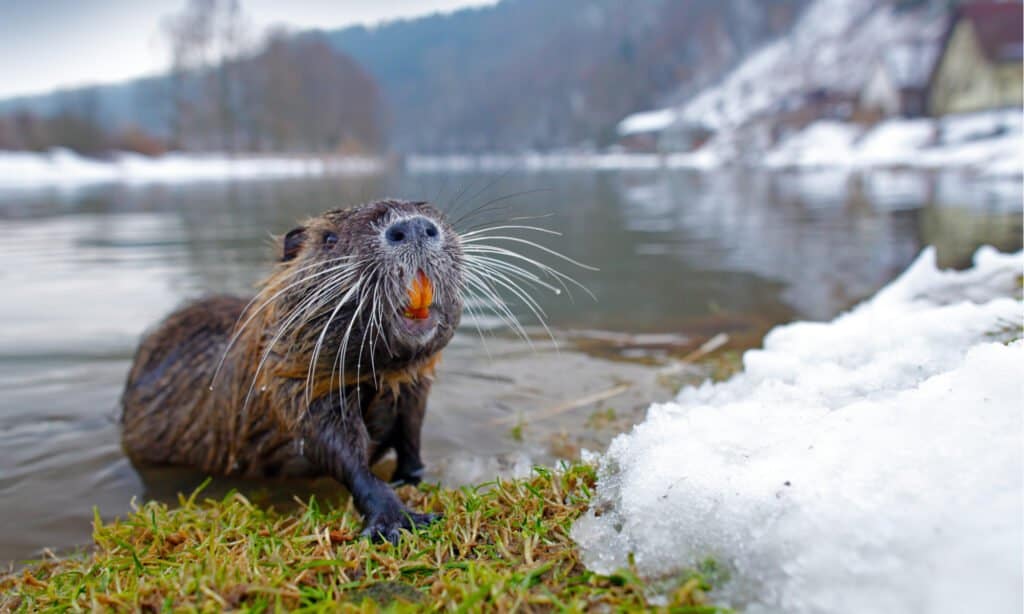
Nutria reproduce quickly, which is one of the reasons they cause problems in new habitats.
©Ondrej Prosicky/Shutterstock.com
Known as also known as coypu or swamp rats, nutrias are large rodents native to South America. However, they have also been introduced to the United States, where they overpopulate and disrupt the natural ecosystem.
Nutrias grow about 17 to 25 inches tall with a 10 to 16-inch long tail. They typically weigh 15 to 22 pounds and look kind of like a small beaver or a giant rat. Nutrias are ravenous animals and often eat every last part of plants, as well as insects and snails. In some areas, they have also been known to eat crops like corn, sugar cane, and rice. They are aquatic animals and live together in burrows connected by tunnels near freshwater.
11. Paca (Cuniculus paca) – 22 Pounds

In some areas, people hunt pacas for their meat.
©LeoMercon/iStock via Getty Images
Also known as the spotted paca or lowland paca, this rabbit-sized rodent lives in Central and South America. Pacas have dark brown fur and white spots on their sides that often connect and look like stripes. They measure up to 32 inches long and can weigh up to 22 pounds.
Pacas prefer to live in swamps, wetlands, rainforest habitats, and areas close to water sources. They are primarily frugivores, which means that they mostly eat fruit. However, they can eat a wide variety of different plants as well. Pacas are nocturnal animals and spend their days sleeping in burrows. They live alone or in pairs, but each member often lives in their own separate den.
10. Patagonian Mara (Dolichotis patagonum) – 20 to 30 Pounds
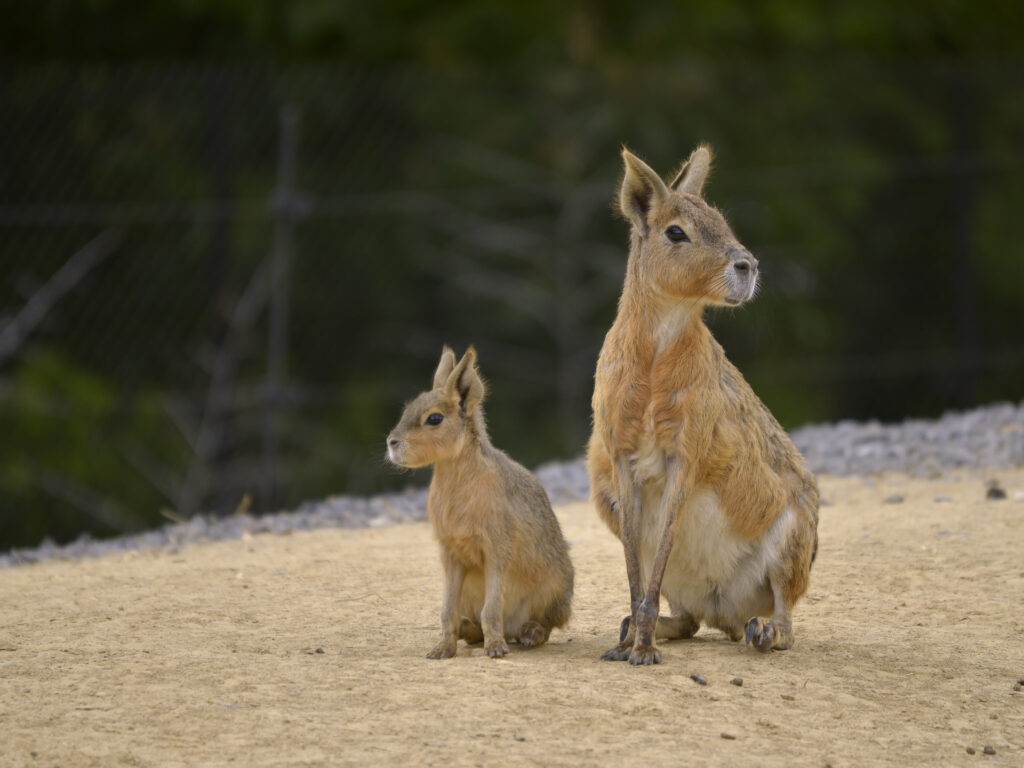
Patagonian maras mainly eat grasses, but on occasion, they may snack on fruits, seeds, and flowers as well.
©Christian Musat/Shutterstock.com
About as big as a medium-sized dog, the Patagonian Mara grows up to 30 inches long and can weigh 20 to 30 pounds. This unusual animal has a stocky face and body like a capybara. However, it also has long skinny legs more like those of an ungulate (a hoofed animal). In addition, it has tall ears and sits with its weight on the back legs like a rabbit. It has dense, gray-brown fur with a white patch on the chest and stomach and orange coloring on the cheeks and chest.
Patagonian maras only live in central and southern Argentina in brushlands and arid grasslands with lots of open space. In addition to their unusual appearance, Patagonian maras can walk, hop like rabbits, gallop, or even bounce on all fours.
9. North American Porcupine (Erethizon dorsatum) – 30 Pounds
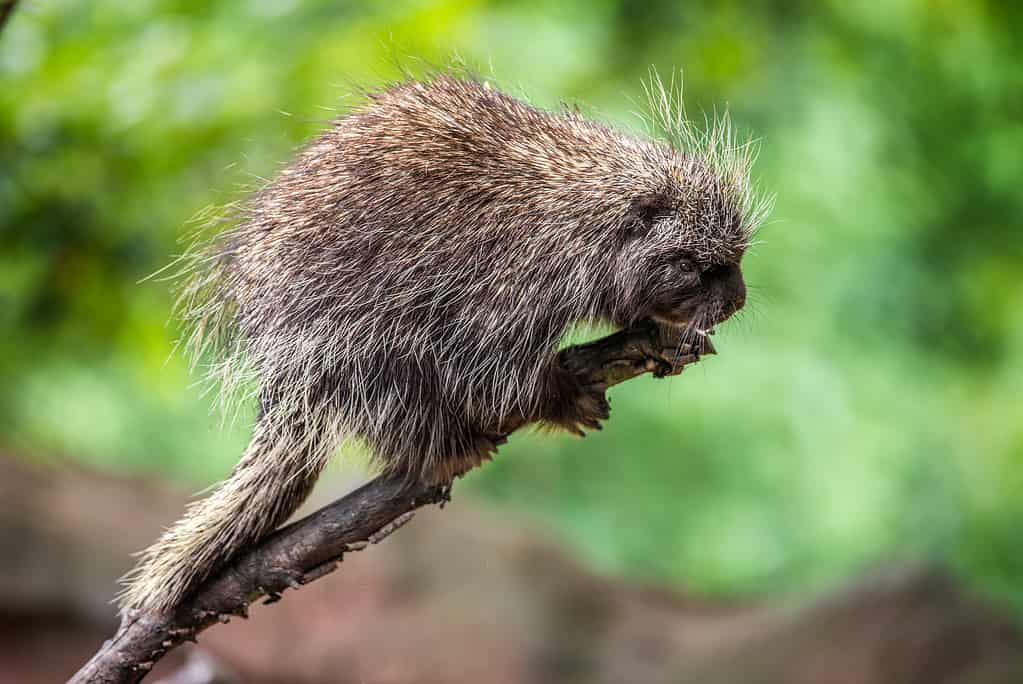
North American porcupines have nearly 30,000 quills!
©miroslav_1/iStock via Getty Images
The second largest rodent in North America is the North American porcupine, weighing in at 30 pounds and growing 2 to 3 feet long. North American porcupines are native to the forests of Canada, the United States, and northern Mexico. They live in a wide range of habitats, from mixed forests and desert shrub communities to grasslands and even tundra. Although North American porcupines are excellent climbers and occasionally build their nests in trees, they spend most of their time on the ground.
8. Pacarana (Dinomys branickii) – 33 Pounds
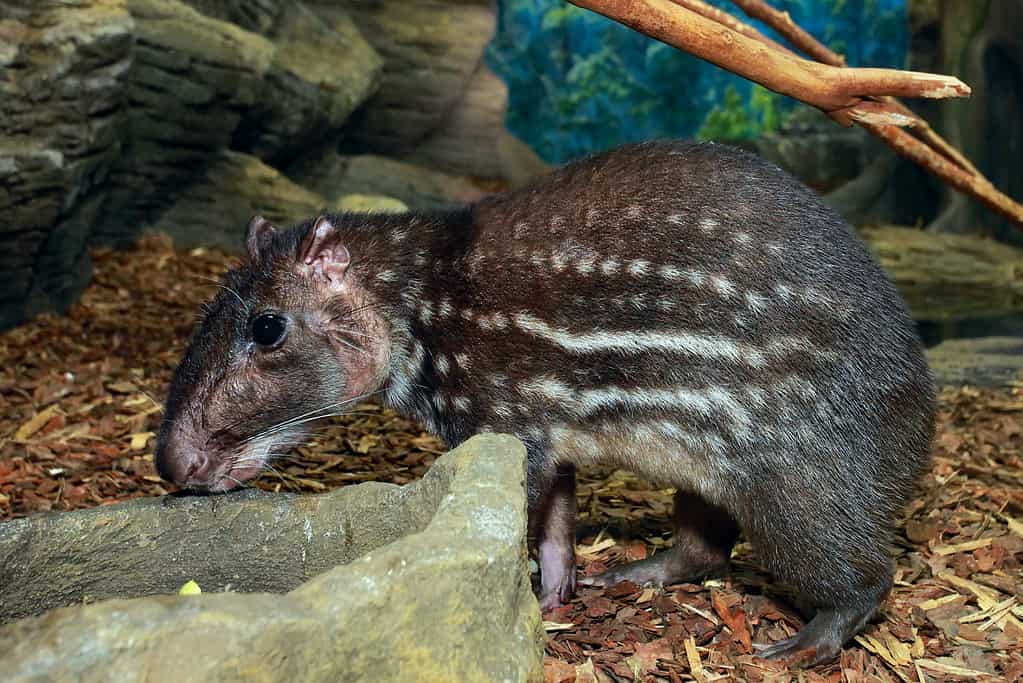
Pacaranas are mostly found in parts of Venezuela, Colombia, and Bolivia.
©TatianaMironenko/ via Getty Images
Scientists still don’t know a lot about pacaranas, as they are very secretive and rare. These large rodents grow up to 31 inches long and weigh up to 33 pounds. They live in Central and South America, often in the hills and valleys of the Andes Mountains.
Pacaranas have dark brown bodies with two white stripes running down their backs and white spots along each side. They have elongated heads, long whiskers, and small rounded ears. When they eat, they often sit back on their hind legs, holding their food carefully between their two front paws. Pacaranas have a complex communication system, with a wide variety of sounds and body movements.
7. Indian Crested Porcupine (Hystrix indica) – 40 Pounds

Porcupines also have thick claws.
©RudiErnst/Shutterstock.com
Native to the Middle East and southeastern and central Asia, the Indian crested porcupine is a large rodent that weighs 24 to 40 pounds. Its body is covered with several layers of modified hair quills. The underlayers contain short, thick quills that cause most of the damage. The top, outer layers have longer, thinner quills. Each quill has alternating bands of white on a brown and black background. Their tails have short, white spines. Some of these quills are also hollow and make loud rattling sounds.
Indian crested porcupines are nocturnal animals and can travel nearly 9 miles at night in search of food. They spend their days sheltering in caves or burrows found in rocky areas, forests, tropical regions, plantations, sandhill deserts, mountain steppes, and even up in the Himalayan Mountains!
6. Lesser Capybara (Hydrochoerus isthmius) – 62 Pounds
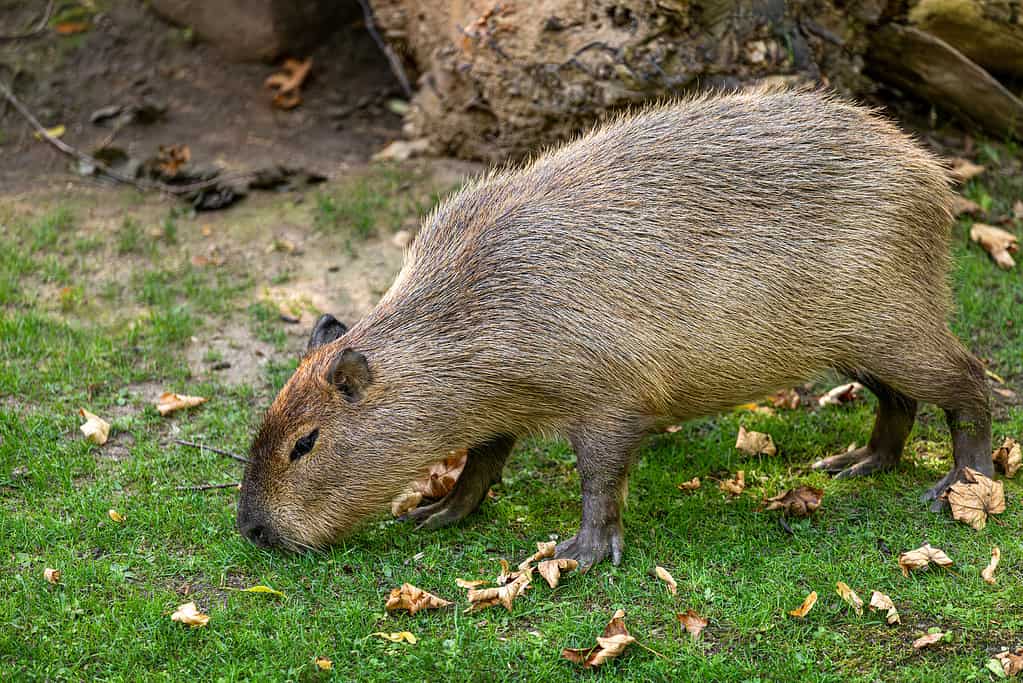
Lesser
capybaras
look a lot like miniaturized common capybaras.
©Vronja_Photon/iStock via Getty Images
Found in western Venezuela, eastern Panama, and northwestern Colombia, the lesser capybara is the third-largest rodent in the world. Although they are closely related to the larger common capybara, lesser capybaras are much smaller, typically weighing up to 62 pounds. Lesser capybara are semi-aquatic mammals and always live near standing water. Although they are social, they are not nearly as gregarious as their larger cousins and often live in much smaller groups.
5. African Crested Porcupine (Hystrix cristata) – 65 Pounds
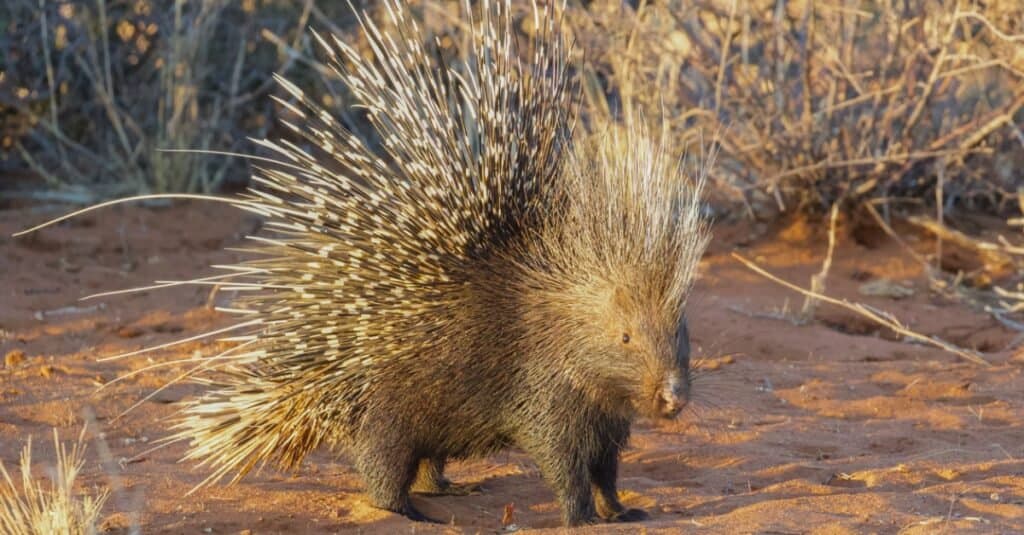
“Porcupine” is Latin for “quill pig”.
©iStock.com/Pedro Ferreira do Amaral
Growing 23 to 37 inches long and weighing 22 to 65 pounds, the African crested porcupine is the sixth largest rodent in the world. Like other porcupine species, its body is covered in sharp quills that range from 1 to 13 inches long.
The African crested porcupine gets its name from its defensive posturing. When it senses a threat, the porcupine raises the long quills on its head and neck, forming a crest that makes it look bigger and more intimidating. It may also stamp its feet, rattle the hollow quills on its tail, and click its teeth. If the threat remains, the porcupine runs backward and rams it with its thick tail quills.
4. Eurasian Beaver (Castor fiber) – 66 Pounds
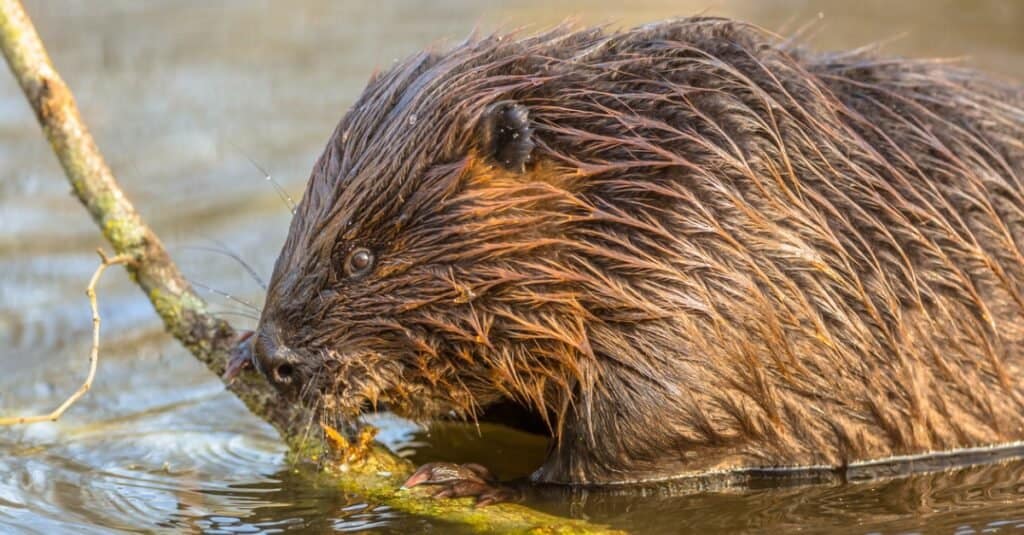
Eurasian beavers are smaller than North American beavers.
©iStock.com/CreativeNature_nl
Growing 3 feet long and weighing up to 66 pounds, Eurasian beavers are the fourth largest rodents in the world — and the largest rodent in Europe! They have a similar appearance to North American beavers. However, their skulls are slightly longer and more narrow, their tails are thinner, and their fur is a bit lighter in color. Eurasian beavers once lived throughout Europe and Great Britain, but sadly they were nearly hunted to extinction.
Due to hunting for their meat, fur, and scent gland secretions (castoreum), these animals completely disappeared in England, Wales, and Scotland. Fortunately, successful conservation efforts and reintroductions have helped populations of Eurasian beavers to recover. These large rodents are extremely important to the ecosystems where they live. As ecosystem engineers, Eurasian beavers build dams that help create wetland areas, providing crucial habitats for other animals like amphibians, fish, and birds.
3. Cape Porcupine (Hystrix africaeaustralis) – 66 Pounds

Cape porcupines are monogamous animals.
©Gilbert S. Grant/Shutterstock.com
Native to Central and South Africa, the Cape porcupine is the largest rodent in Africa. It is the fifth largest rodent in the world and the largest porcupine on Earth. Cape porcupines grow 1.5 to 3 feet long and weigh 20 to 66 pounds. They are very adaptable animals and can live in many habitats. However, they are more common in open areas. Cape porcupines live in small family groups and often shelter during the day in caves, rocky crevices, or underground burrows. At night they hunt for food.
When they walk, Cape porcupines can look a bit awkward. However, they can easily outpace humans and several other animals when they run. Their bodies are covered in long quills and spines made of hardened, modified hairs. Their quills alternate with bold black and white colors, serving as a warning to potential predators. They also have some specially modified hollow quills that they can rattle to make noise. The quills around their back and tail are thicker, shorter, and closer together, serving as another built-in weapon for the porcupine.
2. North American Beaver (Castor canadensis) – 75 Pounds

Beavers help to reduce erosion and o create habitats and resources for other animals.
©Ilkka Koivula/Shutterstock.com
The second largest rodent in the world and the largest rodent in North America is the North American beaver. These enormous rodents grow 3 to 4 feet long and weigh 35 to 75 pounds. They have unique, paddle-shaped tails that are flat and scaly and webbed feet. Their massive front teeth are orange and grow continuously throughout their lives. Beavers are incredible ecosystem engineers, cutting down and shaping trees as they build dams, which can significantly transform their habitat. They are also keystone species.
1. Capybara (Hydrochoerus hydrochaeris) – 150 Pounds
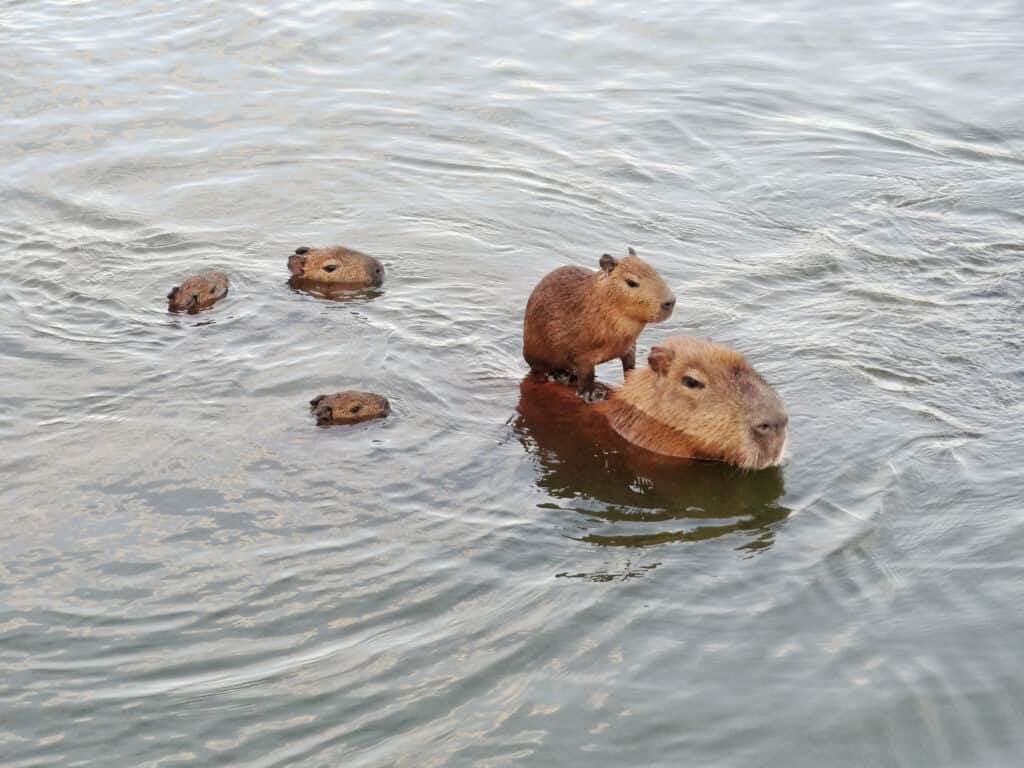
Capybaras have eyes and ears on top of their heads, allowing them to stay mostly submerged in the water.
©iStock.com/Yuina Takase
The largest rodent in the world is the capybara. These adorably large rodents can stand up to 2 feet tall, 3 to 4 feet long, and weigh up to 150 pounds or more! However, they are also calm and friendly animals that are well-known for their social, outgoing personalities. Capybaras have shaggy light brown hair and live in Central and South America. They are semi-aquatic mammals with slightly webbed feet. They are also excellent swimmers and always live near marshes, riverbanks, ponds, and other water bodies. Capybaras can hold their breath and stay underwater for five minutes at a time — a common strategy they use when trying to escape from predators.
Bonus: The Extinct Giant Pacarana (Josephoartigasia monesi) – 772 Pounds

So far, paleontologists have only found a skull from the giant pacarana.
©Andrés Rinderknecht & Ernesto Blanco; Illustration: Gustavo Lecuona / CC BY-SA 2.5 - License
If you think the capybara is big, wait until you see the giant pacarana — this massive rodent was the size of a bison! Around three million years ago, giant pacaranas roamed across the southern regions of South America. Scientists originally estimated that giant pacaranas weighed over a ton, judging by a 1.7-foot-long skull found in Uruguay. However, recent studies suggest it was closer to 772 pounds — a bit smaller, but still a monumental size for a rodent!
Scientists estimate that the giant pacarana had a bite force of over 300 pounds at its incisors (the front teeth), and 936 pounds at its molars (back teeth). However, like many rodents today, giant pacaranas appear to have enjoyed a diet of forest and water plants.
The photo featured at the top of this post is © Ian Peter Morton/Shutterstock.com
Thank you for reading! Have some feedback for us? Contact the AZ Animals editorial team.






